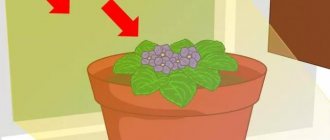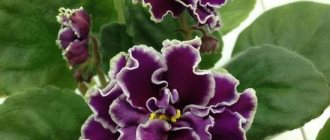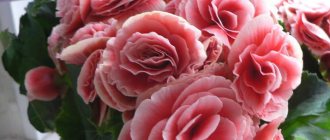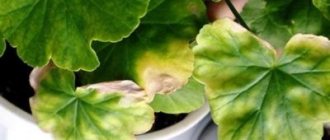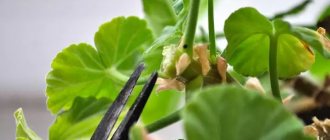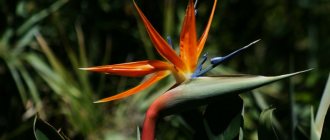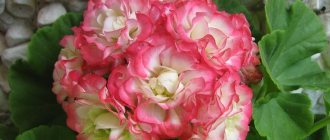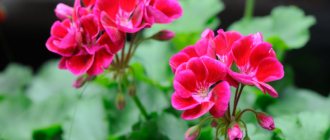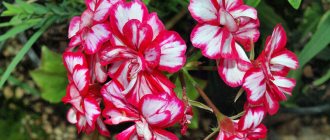Reproduction methods
There are several ways to propagate pelargonium.
Most often, geranium is propagated at home by dividing the bush and cuttings, but it can also be done by seeds. The process is more labor intensive, but the result is a large number of healthy young plants. Propagation by dividing the bush is best done in spring. A plant whose root system has completely filled the pot and is visible through the hole in the bottom of the pot is suitable. An adult bush is watered abundantly and taken out of the pot. The root system is carefully disassembled and, if necessary, cut off with a sterile knife. Each part should have leaves and roots. The cut areas must be treated with activated carbon and cinnamon powder. After separation, the flowers are planted in small pots. 10-14 centimeters in diameter is enough. If the pot is too large, flowering will occur later or will be postponed until the next year until the plant fills the entire volume of the pot with roots. It is necessary to put drainage at the bottom of the pot. You can prepare the soil yourself or purchase it at the store. The soil from the store must be diluted with garden soil and disinfected. To do this, it is calcined in the oven or spilled with a solution of potassium permanganate.
Propagation by cuttings can be carried out throughout the year, but the best results will come from cuttings taken in the spring. During spring pruning, a large number of cuttings remain, which easily take root. The cut branch should have no more than 2-3 leaves. Very large leaves can be cut in half. The cutting is cut at an angle using a sharp knife or blade. It is better to disinfect it first. The cutting is left at room temperature for several hours until the cut is airy. The finished cuttings are placed in a glass of water. It is better to wrap it in dark paper. In the dark, roots will form quickly. You need to add an activated carbon tablet to the water, and cut a cardboard with a hole along the diameter of the neck, into which to place the cutting. It should not sink much in the water, no more than 1 centimeter, otherwise it may begin to rot. Pelargonium takes root easily if it is simply planted in the ground. A regular plastic cup will do for this. Holes are made in it to drain water, fine drainage and soil are poured. The soil should not be very wet, otherwise the plant will not take root and will begin to rot. At first, do not water the cuttings; you can only lightly spray the ground. If it starts to wilt, cover it with a jar.
Propagation by seeds is a long and painstaking process. Before planting, the seeds must be treated. To do this, they are lightly rubbed on fine sandpaper and soaked in the stimulator for 3 hours. Then soak in clean water for another 3 hours. The soil from the store is oversaturated with nutrients, so it is better to make it yourself. Its composition should include peat, river sand and turf soil in a ratio of 1:1:2. The container for the first planting of seeds should be shallow. The seeds are evenly distributed over the surface at a distance of 5 centimeters from each other. Spray with a fine sprayer; if the ground is dry, cover the container with glass. Shoots will appear within a month. After 3-4 leaves appear, you can transplant them into separate cups or directly into small pots.
Comments (4)
Tatiana
09.12.2017 at 13:15 |
I associate lemon geranium with scented geranium. Perhaps this is the same species? This species is very helpful for ear diseases, and it is not difficult to grow; it is a very unpretentious plant.Answer
Yulia Expert Plodogorod
08/26/2019 at 15:35 |
Hello Tatiana! You are absolutely right, lemon geranium is a fragrant variety. This plant really has many medicinal properties and is used for otitis media, colds, headaches and some other problems.
We would like to note that despite all the benefits of this flower, infusions, decoctions and other derivatives from it can only be used as an aid and do not replace the main treatment. It should be used with caution by people who suffer from allergies.
In addition to its medicinal properties, this variety of geranium has a very pleasant, delicate scent. For this reason, it is recommended to grow it in the bedroom, since, according to reviews, the aroma emitted improves sleep.
Despite fairly easy care, due to non-compliance with the basic rules, the flower loses its decorative effect. From lack of moisture, the edges of the leaves may begin to turn yellow. This usually happens with those shoots that are located at the bottom of the plant. But, if the crown begins to turn yellow and the flower generally looks sluggish, most likely the reason is due to excess watering.
In the described case, it is worth normalizing the hydration regime. You can lightly loosen the soil in the pot to speed up its drying. If there is no improvement, a transplant may be required. During the process, it is worth inspecting the rhizome for rotting. The softened and rotten parts are cut off to healthy tissue.
In addition to direct excess moisture, a pot that is too narrow can lead to the described consequences. But you shouldn’t choose too large a container either. In this case, the geranium will begin to spend energy on growing rhizomes, which will affect its decorative effect.
If the geranium does not bloom, then the reason may be insufficient lighting. In such cases, the foliage becomes pale and the shoots become elongated. Buds will not appear if the plant is cold.
Excess nitrogen can also be a problem. In this case, not only may there be no flowering, but also a fungus may develop.
Geranium, like any other plant, needs to be adapted to. If you maintain a balance when watering, lighting and fertilizing, this crop will delight you with a lemon aroma and delicate flowering.
Answer
Ira
04/14/2018 at 00:16 |
This is the first time I’ve heard about lemon geranium, I can’t get regular geranium, they don’t sell it anywhere here or among my friends, I decided to order it in an online store, but now I don’t even know what type of geranium to choose.
Answer
Yulia Expert Plodogorod
08/26/2019 at 16:08 |
Hello, Ira! If you choose an indoor variety, then red, white, fragrant, and also ampelous varieties of pelargonium grow well in such conditions. Since it is not possible to obtain cuttings, we recommend using the seed method of propagating geraniums.
When you receive the planting material, you need to inspect it, it is important to make sure that there is no hard shell on the seeds. If preliminary cleaning has not been carried out, you will have to do everything yourself using sandpaper.
There is no specific time when to plant the described crop. But, if you do not plan to use additional lighting sources, for example, phytolamps, it is better to plant in early spring. Then the daylight hours will increase in proportion to the needs of the sprouts.
To improve germination, it is better to soak the planting material before planting in cold water. Exposure time is 2-3 hours. For greater effect, you can add Epin or another stimulant to the moisture.
To protect the crop from various fungal diseases, you can first hold the seeds in a solution of manganese or boric acid for about half an hour. After such treatment, it is better to rinse the planting material and then place it in a stimulating solution.
You can use a box or glasses to sow seeds. The soil should be very light. You can take turf soil as a basis, to which you add peat and a little sand. We recommend additionally disinfecting the soil mixture by pouring boiling water, manganese solution or Fitosporin over it.
Regardless of the container, you need to make holes in the bottom to allow moisture to drain out, and then lay a layer of drainage. This can be either purchased expanded clay or improvised materials. For example, old sawdust, shells, and small stones are suitable.
If planting is done in a box, you must immediately maintain a distance between seedlings of at least 4.5-5 cm. When planting in glasses, it is better to put one grain there at a time. If any of them do not germinate, it is better to try again than to remove excess sprouts.
The fact is that in the process you can easily damage the root system, not to mention the fact that the flowers will compete for nutrients.
After sowing, the soil is moistened with a spray bottle, and the beds are covered with plastic film. In the future, you need to water the plantings as the soil dries out and ventilate such a greenhouse.
The first green seedlings will begin to appear in 15-20 days. Picking is carried out in separate containers when 3-4 leaves are formed on the seedlings.
Answer
The process and characteristics of flowering
Geranium is an indoor plant that does not require a lot of time and effort to care for. She requires special care during flowering. As soon as the ovary appears, they evaluate whether anything will interfere with the formation of inflorescences.
Why is it important? For example, leaving the flower pots to be “torn to pieces” by direct sunlight, the flowers will not be bright. In other words, a flowering geranium will turn into a weed without taking into account the features from the list below
- In winter, they provide coolness to the plant. The main thing is to know moderation in everything: air temperature in the room below 10⁰C is unlikely to be beneficial, contributing to its premature awakening from a state of rest.
- The “south” window is an excellent place to place flowerpots with pelargonium. She loves the sun, but not in excess.
- Light and nutrition are two mandatory conditions that must be observed by gardeners who want to enjoy flowering all year round.
- The more branches, the more places for flowering. Shoots are pinched to enhance branching.
- As soon as the flowers fade, remove them.
- Pelargonium rejuvenates and gains strength for growth with regular pruning.
If geranium is grown from seeds, it will bloom 130-140 days after sowing. This will happen when the plant has gained good vegetative mass.
On a note. Many gardeners sow geraniums in pots in early February in order to enjoy the beauty of the flowering plant in May.
How long will flowering last? How many buds will appear? If you do not take care of the geranium, do not feed it or apply fertilizers rich in nitrogen, it will not bloom on the 130-140th day. Everything will happen late, and besides, there will be few flowers. This process will be affected by factors: lighting, watering, temperature.
When the amount of phytohormones is sufficient, the formation of flower primordia will occur. Soon exogenous shoots will appear on the growth cone. Sepals will form, then petals.
After the formation of the anther and filament, the stamens will develop. Carpels look like corymbose leaves on short stalks. Their lower side grows more intensively than the upper, resulting in the formation of a cavity with fused edges.
A style and stigma are formed in the upper part of the carpel. These processes occur inside the kidney.
Once the flower is developed, pollination must occur. To do this, the parts of the plant involved in this process must become free and accessible. It happens in different ways.
If you take a pot of geraniums out into the open air, insects will pollinate the flowers. Self-pollination or artificial pollination can also occur. As soon as this happens, the petals and stamens, stylodes and stigmas will fall off.
The calyx will be preserved, as it is needed to protect the ovary, which will later turn into a fruit. The flowering time of one flower is 3-10 days, and there are up to 50 of them in one inflorescence.
Read our material about what to do with faded flowers and whether you need to prune geraniums.
Varieties, varieties and photos of odorous plants
Lemon (Citronella)
A common plant variety and loved by everyone. When you touch it or move the air in the room, it emits a strong citrus scent. This plant is 40-90 cm tall with zonal leaves of a fleecy texture with a small dark spot at the base.
Citronella blooms with inconspicuous inflorescences of pink or light purple color. The growth vector of its stems is directed downwards and over time the plant can form an untidy vine that occupies the entire windowsill. This possible drawback needs to be promptly monitored by the grower.
It is important to pinch the lemon geranium from the very beginning, forming a neat bush. Lemon geranium is widely used in folk medicine for various inflammations and nauralgia.
Fragrant pelargonium (Pelargonium odoratissimum)
A shrub up to 30 cm high with rounded, heart-shaped gray leaves, wavy at the edges. The leaf surface is pleasant to the touch due to the large number of short silky hairs. The most fragrant geranium blooms with small white flowers, with crimson marks on the two upper petals.
Flowers of 5 pieces are collected in inflorescences. This type of geranium exudes an apple-mint aroma. The most fragrant (fragrant) geranium is suitable for indoor floriculture, but the plant does not tolerate proximity to heat sources. The scent of fragrant geranium is a good repellent for insects. Moths and mosquitoes will leave the room if you place a pot with this plant there. But the disadvantage of this type of geranium is possible allergenicity. It cannot be placed in a children's room.
Candy Dancer
Geranium, whose name literally translates as “Candy Dancer,” smells like the oriental sweetness of Turkish delight. Its leaves are dissected, light green, with white edging along the edges. The flowers are small, light pink. This geranium grows well indoors.
By placing several pots with this plant in the recreation area, you can enjoy the unusual sweet aroma at any time of the day. Some gardeners note the sweet smell as cloying and consider this a disadvantage of this variety.
Lady Plymouth
One of the first types of fragrant geranium, which was obtained in Great Britain. He has many hybrids with different aromas, there are plants with the smell:
- eucalyptus;
- roses;
- mint and many others.
This type of geranium has dissected green leaves with a light edge, and small pale lilac flowers.
Grows well indoors, but does not like heavy winter watering. It can easily tolerate dry air, but requires maximum lighting.
Mable Gray
This type is one of the most fragrant geraniums and has a persistent lemon-mint aroma. Flower growers consider it a real treasure for several reasons:
- Firstly, externally the plant is a spectacular bush with graceful maple-shaped leaves. The texture of the sheet is distinguished by clearly defined veins and fibers on the inside of the sheet.
- Secondly, the plant is often used as the basis for a standard crop.
- Thirdly, the plant is stubborn to rooting cuttings, it is difficult to propagate, and this is considered the only drawback of the Mabel Gray geranium.
Gray lady
It is a small bush with spectacular silver leaves with an openwork edge. The flowers are white, collected in small umbrellas, appear in summer. Does not tolerate waterlogging of the soil, or, conversely, excessive dryness of the earthen clod. This delicate, lacy plant releases natural, volatile aromas upon contact, similar to menthol.
Where and how to plant it?
Indoor geranium is considered a non-capricious flower (find out all about the types and varieties of indoor geranium here). Despite the fact that it is a native of warm countries, it easily tolerates cold winters of temperate latitudes. The most suitable place for the plant is a spacious room with plenty of light and fresh air.
Herbalists advise placing the flower in the bedroom, as Pelargonium graveolens improves sleep. It also cleans the air well from germs and unpleasant odors, so the second location option would be the kitchen. In summer, the flower can be taken outside, but hidden under a canopy from direct sunlight.
For the full development of geraniums, it is important to choose the right pot. For an adult plant, the appropriate size is 20-25 cm in diameter and 3-4 cm in height
It is preferable to choose clay as the material for the planting container. In a plastic flowerpot, the root system rots. The container should be updated as the plant grows. If the flower does not have enough space, it begins to die.
Lighting and location
Lemon geranium is a light-loving flower, but can grow even with little light in the back of the room. It will immediately let the owner know about the lack of lighting by its appearance. If there is not enough light, the leaves will turn light green. The plant itself will stretch upward, the shoots will be thin and long. To correct the situation, you need to place the flower in the sun for about 6 hours. This is exactly how much time a day geraniums need for full growth.
In a room, it is better to place geraniums on window sills on the western or eastern side. At the same time, the place must be completely protected from possible drafts. It is not recommended to place the flower under a stream of hot or cold air, that is, directly near heating devices or under an air conditioner.
To stimulate flowering, additional artificial lighting should be used.
Soil requirements
For planting and replanting lemon geranium, choose a special or universal soil.
The following components, taken in equal proportions, are considered the optimal composition for geranium:
- coarse fractional river sand;
- peat;
- charcoal;
- humus;
- turf land.
Soil acidity plays an equally important role in the further growth of Pelargonium graveolens. She does not tolerate a drop in pH to 5.5, in which case she stops feeding. The ideal acidity ratio is pH 6.5. The soil should be neutral or slightly acidic.
Chemical composition of the plant
The chemical composition of geranium is very rich; the leaves and stems contain the following substances:
- essential oils;
- organic acids;
- starch;
- Sahara;
- pectin;
- mineral salts;
- anthocyanins;
- vitamins;
- geranine, etc.
The plant contains no toxins, alkaloids, or toxic substances; it cannot cause poisoning.
Home care
Let's look at the basic recommendations for caring for this miniature plant.
Watering
This plant must be provided with moisture regularly and in sufficient quantity. In summer, it is better to water every other day, and in winter, the number of waterings should be reduced to once a week. It is not recommended to allow excessive moisture: the soil should be dry before the next watering.
Carefully loosen the soil after each watering, since regular and sufficient oxygen access to the roots is very important for dwarf pelargonium.
Dwarf pelargonium does not need spraying: this procedure can only damage its foliage and flowers.
Top dressing
The plant needs regular additional nutrition throughout the growing season from March-April to October-November. In winter, dwarf pelargonium is not fed, giving it time to rest.
The plant especially needs phosphorus and potassium, but you need to be careful with nitrogen: with an excess of this microelement, the green mass of dwarf pelargonium actively grows, but the flowers are in no hurry to form.
Advice! It is recommended to use complex fertilizer for pelargoniums: all components in this composition are selected in the best and most optimal way. The frequency of fertilization is once every couple of weeks.
Molding
In order for the bush to please the eye with its splendor, it is necessary to regularly pinch the young shoots. This measure will allow the plant to form a larger number of lateral branches, and its overall decorative effect will thus only benefit. Additionally, we note that to form a dense compact bush of good shape, it is recommended to grow dwarf pelargonium in spacious containers, although it will bloom better in cramped ones.
It happens that during the winter some shoots stretch out quite significantly compared to others. With the onset of spring, it is recommended to shorten such “vigorous” specimens by a third of their height. If the cuttings cut during molding are healthy and strong, they can be rooted. Thus, your farm will add more beautiful graceful pelargoniums.
Care for fragrant geranium
The predecessor of the geranium genus is the plant Pelargonium triste, which grew wild in a subtropical climate. The ancestor of the family was originally found in southern Africa. Therefore, when keeping fragrant geranium at home, it is necessary to provide proper care.
What should the lighting be for the plant?
Although geranium is a southern plant, it still needs to be given a place in the room where direct ultraviolet rays will not reach the foliage. It is better if the pot is in a little shade.
Due to the burning rays, the plant undergoes stress. For this reason, hanging leaves can be observed on the bush. Under the influence of ultraviolet light, the fragrant crop becomes lifeless and lethargic. If the pot is placed in a shady place, then after a short time the foliage will straighten and look healthy.
In its natural habitat, the plant stays in daylight much longer than when grown indoors. In our temperate latitude, a fragrant flower can feel ideal if the pot is placed on a windowsill on the south side. In other cases, it is necessary to organize additional lighting using cold glow lamps.
Temperature
With proper care of home vegetation, it is necessary to maintain a correctly set temperature regime, which will at least approximately correspond to the air temperature of a subtropical climate.
During the spring growing season of fragrant geranium, as well as in summer and early autumn, the room temperature should be maintained within +25-28 C. When the plant goes into dormancy, the temperature is lowered to +14-16 C.
If a fragrant flower has been growing in a flowerbed all summer, then with the onset of autumn the plant is carefully dug up and, together with a lump of earth, placed in a prepared pot. The plant can be placed in a utility room, where the temperature is within +10-12 C, but not lower.
How watering and fertilizing occurs
The fragrant crop came to our territory from Africa, so it is drought-resistant. The plant does not tolerate excessive watering. Due to excess moisture, the leaves of the flower droop. Geraniums need to be watered as the top soil layer dries out.
Depending on the temperature in the room, the frequency of watering is adjusted. In summer, the plant can be watered every few days, but in winter, watering is reduced. It will be enough to moisten the plant’s soil a couple of times a month.
During the growing season, when the plant is actively developing, the flower needs to be fed with useful microelements. Fertilizer is applied from early spring to autumn. It is useful to water geraniums with liquid fertilizers. Frequency: once every 14 days.
Before this procedure, the flower is watered abundantly so as not to burn the root system, and the next day the flower can be fertilized. Feeding mixtures may contain a high content of potassium and phosphorus elements.
Soil for geraniums
The fragrant flower is not too picky about the soil substrate. A good option would be forest soil, thoroughly cleared of foreign rhizomes and harmful insects. To disinfect the soil, you can heat it at high temperature in the oven.
When choosing soil, you need to be guided so that it is not depleted. Minerals are important for any vegetation. Clay soil is not suitable for fragrant geraniums.
As a last resort, such soil can be mixed with coarse sand. Dense soil will not allow the root system to develop normally. The clay layer has poor oxygen access, which can negatively affect the roots of fragrant geraniums. The top layer of soil must be loosened periodically.
Care during the flowering period
When geranium blooms, it requires a lot of care. Beautiful fragrant inflorescences take a lot of nutrients from the plant, so the stem begins to starve without fertilizing and becomes depleted.
The flowering of the crop can be observed at the moment when the spring sun's rays heat the earth more strongly. The beauty of the inflorescences can be admired throughout the summer. In winter, geranium goes into a dormant period, since the plant does not have enough natural light to form inflorescences.
Flowering can be made brighter and longer if the room is ventilated from time to time. According to flower growers, the volume of the inflorescences will become larger if the bushes are topped with iodine water. The solution is prepared as follows: add 1-2 drops of iodine liquid to 1 liter of water.
When the buds have opened their red-scarlet caps, it is not advisable to spray the plant with a spray bottle; the inflorescences certainly will not like this shower. During the period of mass appearance of inflorescences on the plant, the time comes to apply complex mineral fertilizer. Suitable mixtures for ornamental plants. Feeding can be done once every 30 days.
Trimming and pinching
In early spring, you need to look at the bushes; if the stems of the geranium have become too elongated over the winter, you can prune them. The procedure is done exclusively in the spring to return the plant to its decorative appearance. Also, pruning the stems stimulates the formation of flower buds.
If a shoot has formed in the area of the leaf axils, it is advisable to pinch it off, since such a shoot only spoils the appearance of the plant. All yellowed, old and dead leaves are removed from the bush. It is recommended to leave no more than five growth buds on the stem. After pruning, the fragrant plant needs to be fed.
Pinching is carried out when the flower emerges from the “dormant state”. Usually the procedure occurs in February or the first month of spring. Using pinching, excess growth points are removed. This helps increase the lushness of foliage and bushiness of shoots.
There can be several pinching methods. Each option depends on the cultivation of scented geraniums. For example, if the plant was grown from seed, then it should be pinched on the sixth leaf. When growing geraniums by cuttings - on the eighth leaf.
Using this technique, underdeveloped shoots that develop inward are removed from the bush. Such small shoots only interfere with normal air access. They can contribute to moisture stagnation.
Crop care in spring and winter
In order for a fragrant crop to bloom magnificently and abundantly, it is necessary to create a normal dormant period for it. During the period when winter frosts are crackling outside the window, in the room where the pot of geranium is located, it is advisable to maintain the air temperature up to +12-15 C.
On autumn and winter days, daylight hours are reduced. Short-day lighting will not be enough for the plant, so it will have to be illuminated using cold lighting lamps or other artificial lighting.
From the first autumn days you need to gradually prepare the plant for the dormant period. The flower is inspected and, if necessary, yellowed or diseased foliage is removed. It is advisable to place the pot in a place where there is sufficient lighting. Extending daylight hours will have a positive effect on the decorativeness and intensity of flowering of fragrant geraniums.
In winter, the plant is often not watered so as not to destroy the root system. The same applies to the application of fertilizing fertilizers. If the plant cannot reduce the temperature during the cold season, then watering remains normal. Due to exposure to dry air from heating systems, the top layer of soil can quickly dry out. When ventilating the room, the flower pot should be temporarily removed from the window.
Propagation of fragrant geranium
The plant can be propagated by all methods suitable for indoor flower crops. Cuttings root quickly and successfully. Non-hybrid varieties of geranium can be propagated from seed.
Cuttings
A good option would be to choose a plant stem that is not too old for cuttings. Geranium is not a perennial indoor flower. After 4-5 years it can completely degenerate, so the bushes need to be rejuvenated.
The easiest way to grow a crop is from cuttings. They can be cut and rooted throughout the active growing season: from March to September. The procedure is compatible with spring pruning of the bush.
Medicinal properties and uses
The air in the house where fragrant geranium grows is filled with phytoncides and essential substances that have a calming effect on people's condition. Geranium is an excellent antiseptic. The medicinal properties of this species are truly inexhaustible:
- healing aroma relieves fatigue, irritability and normalizes sleep;
- a compress of mashed leaves relieves lumbar and joint pain;
- concentrated geranium juice promotes the healing of wounds and ulcers on the skin;
- medicinal infusions and decoctions have an effective anti-inflammatory effect for otitis media, sore throat, inflammation of the intestines and stomach;
- the smell of geranium has antidepressant properties.
What does the most fragrant houseplant look like?
Fragrant geranium is the raw material for the production of geranium oil, which has found extensive use in the perfume industry, cooking and cosmetology. Aroma lamps with geranium oil are widely used in everyday life. In addition, crushed leaves are added to tea mixtures and fruit desserts.
Despite the unique medicinal properties of geranium, preparations based on geranium raw materials have some contraindications, namely:
- pregnancy, childhood;
- allergic reactions, individual immunity;
- stomach ulcer, gastritis, hypotension.
Fragrant geranium is a truly amazing plant; it is considered a talisman of the home and the guardian of the family hearth. In a house with this plant, special psychological comfort and a cozy atmosphere are established.
What is it and how is it different from other types?
This modest plant cannot boast of beautiful flowering, but its leaves are very decorative. They are distinguished by their openwork and look like snowflakes. And the main distinguishing property of this flower is its unforgettable aroma, which can be felt by lightly touching the plant. Scented geranium leaves may smell like:
- lemon;
- pineapple;
- apple;
- strawberries
There are about 150 aromas that are inherent in different types of this plant. Not long ago, breeders developed a hybrid with the aroma of Coca-Cola. The smallest hairs on the stems and leaves of geranium are responsible for the distribution of the subtle aroma; they contain:
- essential oils;
- flavonoids;
- organic acids.
The phytoncides that fragrant geranium releases into the air are capable of improving the health of the air at a distance of 3 meters from the plant, having a detrimental effect on pathogenic microorganisms. Sleep in a room with geranium will be strong and calm.
Important! Not everyone likes the strong aroma of fragrant geranium, and it can also cause allergic reactions. At the first signs of intolerance to the smell of geranium, or redness and itching after contact with the plant, you must immediately take the flower to another room, ventilate the room and consult a doctor.
Description of the plant: lemon geranium
Pelargonium is a species of the Geramiaceae family. Fragrant pelargonium is often called scented geranium. The confusion in names occurs because the plants have very similar foliage and are all identified as the same family.
Geranium is a plant called Herb Robert, as well as cranes-bill because of the shape of the fruit's seed pod, or storks-bill for its resemblance to a bird's beak.
Lat. Geranium (photo)
Pelargonium leaves have a very distinctive appearance. They have beautiful, sometimes deep slits, and their curved shape resembles a ruffled frill.
The color spectrum of their foliage is from light green to dark green, and the leaves of some species have cream, red and even purple colors. The plant reaches a height of 30 to 80 cm.
The geranium family of the genus Pelargonium has more than 200 species. Among them, the five most common types can be identified:
- decorative deciduous;
- ivy or balcony;
- fragrant;
- English, they are noble;
- zonal (standing).
You can also pay attention to the sixth type - these are succulent pelargoniums; they have fleshier stems and an original appearance, for which they are often used in ikebana and bonsai compositions. The leaves of the described flower are oblong, lush due to their dissection, and have a bright green color
With proper care, the plant grows up to half a meter in height, sometimes even higher
The leaves of the described flower are oblong, lush due to their dissection, and have a bright green color. With proper care, the plant grows up to half a meter in height, sometimes even higher.
But it is believed that the decorative function is better performed by a young flower, while the plant trunks have not yet become lignified. This plant looks very fresh and tender
Lemon geranium got its name because of the aroma it exudes with every slightest touch. What does this geranium smell like? The fragrance of this plant is reminiscent of the fresh and sparkling smell of lemon. This geranium is the most fragrant indoor plant.
Common diseases and pests
Lemon geranium is quite resistant to various kinds of diseases . Most often, troubles happen due to improper care. As a result, the plant:
- leaves turn yellow;
- the root system rots;
- yellow or white spots appear;
- the green mass fades;
- no flowering;
- The red color appears at the ends of the foliage.
Such symptoms can be easily eliminated by optimizing the maintenance parameters and adjusting the principles of care.
Sometimes gray mold disease occurs in lemon geraniums . You can get rid of it by cutting off damaged shoots and treating the flower with antifungal drugs. These drugs are also used before wintering plants for preventive purposes.
If geranium is affected by infectious diseases, which is rare, then it is best to use fungicides for treatment.
Due to the intense smell and thick leaves, the flower of this variety is practically not affected by harmful insects. Only white flies and sometimes aphids can be a nuisance, but they can be easily eliminated with soapy water or insecticides.
Where and how to plant it?
Indoor geranium is considered a non-capricious flower (find out all about the types and varieties of indoor geranium here). Despite the fact that it is a native of warm countries, it easily tolerates cold winters of temperate latitudes. The most suitable place for the plant is a spacious room with plenty of light and fresh air.
Herbalists advise placing the flower in the bedroom, as Pelargonium graveolens improves sleep. It also cleans the air well from germs and unpleasant odors, so the second location option would be the kitchen. In summer, the flower can be taken outside, but hidden under a canopy from direct sunlight.
For the full development of geraniums, it is important to choose the right pot. For an adult plant, the appropriate size is 20-25 cm in diameter and 3-4 cm in height
It is preferable to choose clay as the material for the planting container. In a plastic flowerpot, the root system rots. The container should be updated as the plant grows. If the flower does not have enough space, it begins to die.
Lighting and location
Lemon geranium is a light-loving flower, but can grow even with little light in the back of the room. It will immediately let the owner know about the lack of lighting by its appearance. If there is not enough light, the leaves will turn light green. The plant itself will stretch upward, the shoots will be thin and long. To correct the situation, you need to place the flower in the sun for about 6 hours. This is exactly how much time a day geraniums need for full growth.
In a room, it is better to place geraniums on window sills on the western or eastern side. At the same time, the place must be completely protected from possible drafts. It is not recommended to place the flower under a stream of hot or cold air, that is, directly near heating devices or under an air conditioner.
To stimulate flowering, additional artificial lighting should be used.
Soil requirements
For planting and replanting lemon geranium, choose a special or universal soil.
The following components, taken in equal proportions, are considered the optimal composition for geranium:
- coarse fractional river sand;
- peat;
- charcoal;
- humus;
- turf land.
Soil acidity plays an equally important role in the further growth of Pelargonium graveolens. She does not tolerate a drop in pH to 5.5, in which case she stops feeding. The ideal acidity ratio is pH 6.5. The soil should be neutral or slightly acidic.
The right soil for planting geraniums
The percentage of soil acidity plays an important role when planting such a flower. The plant does not tolerate soil acidity lower than 5.5 pH, otherwise the plant stops feeding.
For normal nutrition of pelargonium with the smell of lemon, the soil must be slightly acidic and equal to 6.5 pH.
Expert opinion
Yulia Yurievna
I have a large garden and vegetable garden, several greenhouses. I love modern methods of cultivating plants and mulching the soil, and I share my experience.
Ask a Question
1.Seven secrets of success:
| 1. Growing temperature: can be grown all year at a temperature of 18 to 25°C. During the winter months, you can provide a cool dormant period at a temperature of 7 - 13 ° C so that the plant does not suffer from insufficient light. |
| 2. Lighting: A brightly lit location with access to direct sunlight during the morning and evening. |
| 3. Watering and air humidity: water regularly throughout the year, slightly drying the soil surface between waterings. It is better to increase air humidity. |
| 4. Pruning: the plant needs regular pinching of young shoots and timely removal of aging yellow leaves. |
| 5. Soil: preferably rich in organic matter, light, nutritious, with good drainage. |
| 6. Feeding: 2 times a month, with mineral fertilizers in spring and summer. When kept warm, they also feed in winter, reducing the frequency of watering to once a month. |
| 7. Reproduction: easily propagated by apical and stem cuttings in spring and summer, less often by sowing seeds in spring. |
Botanical name: Pelargonium graveolens.
Family
Fragrant indoor geranium is the birthplace of the plant. Cape Province in southern Africa.
Description. Fragrant geraniums or pelargoniums are the most unsightly of geraniums; they are grown as houseplants for their fragrant leaves with the scent of mint or lemon. Lemon-scented plants are especially fragrant—even the slightest touch of the leaves causes them to release a fresh, citrusy aroma into the air. There is also geranium with an apple-cinnamon scent. Many of these species become too large to grow indoors. They have very attractive carved thin leaves with slight pubescence. The flowers are pink or purple, small and not of particular interest. Sometimes the plant is also called fragrant geranium.
Height. 30 - 45 cm. Some pelargoniums can reach impressive sizes and need pruning.
Use in folk medicine
Fragrant geranium has long been used in folk medicine. Due to its high content of essential oils, pelargonium is widely used in soap making, cosmetology and perfumery. Phytoncides secreted by the plant help improve the microclimate in the room, cleanse it of germs and refresh the air.
Healing effect
The green part of the plant contains saponins, catechins, alkaloids, anthocyanins and flavonoids - chemical compounds with tanning properties, antiviral and antibacterial effects. Contains macro- and microelements, vitamins C and K, carotene. An important element that has an antimicrobial effect and is widely used in perfumery and cosmetology is aromatic alcohol - geraniol.
Indications
The range of uses of pelargonium is very wide. It has antiseptic, analgesic, diuretic, antiviral, bactericidal, antidiabetic and hemostatic effects.
Preparations based on pelargonium are used to treat laryngitis, otitis media, sinusitis, tonsillitis and tonsillitis. It relieves pain well with intercostal neuralgia, osteochondrosis, radiculitis, and heel spurs. To do this, rub the sore spot with a fresh geranium leaf and wrap it, creating a thermal effect. Used in the treatment of the female reproductive system (PMS, ovarian cyst). Traditional medicine is used in the treatment of pediculosis. The calming properties of pelargonium and its beneficial effects on the nervous system are known. Helps with neurasthenia, insomnia, headaches. Helps stop bleeding in the stomach, uterus, lungs and nose. Insects avoid meeting this plant. It helps in the fight not only against moths, but also against mosquitoes. Wound healing properties are used in the treatment of boils, ulcers, eczema, frostbite and cuts.
Contraindications
Like any medicine, geranium-based preparations should be used after consultation with a doctor. It is not recommended for use by children under 6 years of age and pregnant women, as well as women during lactation. May cause allergies and asthma attacks.
Fresh leaves and juice
Fresh leaves help during inflammatory processes in the intercostal muscles and otitis media. The leaves are crushed and applied as a compress; they can be rolled into a tube and inserted into the ear.
Decoction
A decoction can be prepared from dry and fresh leaves. Some recipes use roots and flowers. To prepare the decoction you will need 1 tbsp. a spoonful of dry leaves and a glass of boiling water. The raw materials are boiled for one minute and left for 30 minutes. Take one tablespoon of the decoction with meals three times a day. Tea made from geranium leaves is recommended for insomnia, neuroses, and digestive disorders.
A decoction can be prepared from the root for external use. Used in otolaryngology, cosmetology, and for hypertension. To prepare the decoction you need one tablespoon of dry root and a glass of boiling water. The decoction is infused for 2 hours.
Infusion
Cold infusion preserves as much of the nutrients from the leaves and root as possible. For one glass of cold boiled water, finely chop 10 leaves and add 1 teaspoon of honey. Leave for 8 hours. The infusion relieves inflammation of the eyes, heals wounds on the skin, and relieves inflammation in the mouth and throat.
Tincture
To prepare the alcohol tincture you will need 3 tbsp. spoons of crushed leaves, 0.5 cups of alcohol. Leave for 7 days at room temperature. Apply 0.5 teaspoon 2 times a day, after diluting with one tablespoon of water. Treat the throat and mucous membranes with a diluted solution, wash the wounds, and also use it orally before bed for insomnia.
Essential oil
About a century ago, this oil had other names. It was called palmarosa, rose and cedreoli oil. The oil is obtained from the aerial part of the plant by steam distillation. The main producers are countries such as Algeria, France, Bulgaria, Tunisia, Spain, Morocco, Italy. But the oil grown and obtained on Reunion Island is most valued. Geranium is also cultivated here in Crimea, as well as in Georgia, Armenia, and Tajikistan.
Essential oil has:
- antiseptic,
- soothing,
- restoring performance,
- painkillers,
- tonic,
- diuretic,
- vasoconstrictor
- anti-inflammatory,
- bactericidal,
- deodorizing,
- hemostatic,
- antidiabetic,
- insecticidal,
- healing,
- contracting,
- cytophylactic effect.
You can use essential oil as aromatherapy at home. 2-3 drops per aroma lamp is enough. This will help adjust biorhythms, cope with insomnia, and reduce blood pressure.
Cosmetology
The oil has regenerating properties, which makes it indispensable for caring for dull and aging skin. It can remove facial wrinkles, improve facial contours and retain moisture in the skin. Helps fight acne. The oil is not applied to the skin in its pure form, but added to the base oil, which can be used as grape seed oil, apricot, peach, almond, jojoba or olive oil. Add 4-5 drops of essential oil to 10 ml of base oil.
Methods for propagating geraniums
To propagate indoor geraniums, seeds are usually used (they can be bought in stores) or apical (stem) cuttings taken from adult plants.
Cuttings
Geranium cuttings can be carried out at any time of the year, but most often it is done in spring or autumn. This propagation process is considered quite easy, in addition, it allows you to preserve all the characteristics of the variety. This is usually done using a cutting taken from the top of the plant. Its optimal length is from 6 to 15 cm. For dwarf species, 3 cm cuttings will be sufficient. The cut is made at an angle. The flowers and lower foliage are removed from the branch, the cut area is dried, and then placed in water and put away in a fairly bright place. Instead of water, you can immediately plant the branch in light soil. Such a cutting quickly forms roots - as a rule, after a couple of weeks it can already be transplanted into its own pot. Such plants do not need shelter. For greater splendor of the future bush, you can pinch them above the 5th leaf.
Geranium essential oil: benefits and harms
Essential oil of fragrant pelargonium is included in elite French perfumes and cosmetics. In countries with tropical and subtropical climates, this plant is grown on an industrial scale. The oil is produced from young leafy shoots. It contains about 270 components, the most valuable of which are citronellol and geraniol.
Geranium oil is used in the food industry to add flavor to confectionery products and drinks.
In medicine, oil has been used since ancient times to treat infectious diseases, including pneumonia. It also stimulates the adrenal glands and has a tonic, calming, antispasmodic and wound-healing effect.
Sometimes individual intolerance to geranium oil and allergies to it occur. In such cases, its use may be harmful.
Properties for the human body
Geranium is one of the few plants that has been widely used for medicinal purposes for many decades. All kinds of extracts from the flower make it possible to restore important metabolic processes, as well as cope with the body’s various pathologies and environmental challenges. That is why cultivating a bush on a windowsill is considered quite beneficial for health.
Benefits and medicinal properties
The plant has the following beneficial effects on the body:
- bactericidal;
- antitumor;
- insecticidal;
- antiseptic;
- restorative;
- antidiabetic;
- immunomodulatory.
- All kinds of products based on fragrant pelargonium are used to treat:
- pathologies of ENT organs;
- neuralgic disorders (as a sedative);
- manifestations of PMS and other gynecological problems;
- pediculosis;
- damage to the organs of the circulatory system, including internal bleeding;
- cuts and other damage to the skin (as a restorative and antitumor drug);
- ARVI (as a natural repellent).
Contraindications and harm
The benefits of geranium for human health are undeniable, but the plant can also have a negative effect on the body.
- First of all, it is not recommended to use decoctions, infusions and other flower extracts for:
- individual intolerance to individual components, manifested by allergies;
- diseases of the liver and gastrointestinal tract;
- pregnancy and breastfeeding;
- acute and chronic hypotension.
If general recommendations for use are not followed, including neglecting contraindications, products from fragrant pelargonium can aggravate the general condition of the body and cause allergic manifestations on the body. In addition, the plant is capable of increasing blood viscosity, which can have an ambiguous effect on the circulatory system affected by various pathologies. That is why such folk therapy must be agreed upon with doctors.
Chemical composition
The healing properties of geranium are due to its rich natural composition. The abundance of vitamins and beneficial microelements makes it suitable for use for medicinal purposes. In geranium, all parts of the plant have a healing effect - flowers, leaves and roots.
The chemical composition of the plant includes:
- vitamins - carotene, ascorbic acid (E),
- macro- and microelements - nickel, zinc, manganese, iron, copper;
- flavonoids;
- tannins and mucous substances;
- essential oils;
- phytoncides;
- alkaloids;
- pectins;
- fructose and glucose.
The composition of geranium roots is rich in phenols, and the upper part of the green part is rich in sucrose, starch, phenolic compounds and hemicellulose. The leaves contain flavonoids, pigments, essential oils, vitamins and phenolcarboxylic acids.
Sources used:
- https://rostok.info/komnatnye-rasteniya/cvetushhie/geran-dushistaya.html
- https://plodogorod.com/cvety/sadovye/geran-limonnaja.html
- https://potokudach.ru/others/dushistaja-geran-lechebnye-svojstva-i-protivopokazanija-uhod-za-rasteniem-v-domashnih-uslovijah/
- https://fitohome.ru/poleznye-svojstva/geran-poleznye-svojstva.html
Cosmetology
Fragrant geranium has found wide application in cosmetology. The plant extract is included in some cosmetic products. Special masks for hair skin are prepared at home.
Geranium has amazing properties:
- strengthens the hair structure and prevents hair loss;
- rejuvenates the skin and saturates it with beneficial compounds;
- improves skin tone and improves its color;
- reduces sebum production, eliminates acne and skin rashes;
- eliminates the peeling process, etc.
Fragrant geranium is used to treat acne, purulent skin diseases, inflammatory reactions and rashes. Both geranium itself and its oil are used for cosmetic purposes.
Geranium oil has an antioxidant, regenerating and anti-inflammatory effect and is used to treat eczema, wounds, burns and even frostbite.
To prepare a refreshing toner for dry and mature skin you will need 1 tbsp. l. vodka, 1 glass of flower water and 2 tbsp. l. medicinal chamomile, drops of rose essential oil and 4 drops of geranium oil. Mix all ingredients and pour into an airtight container. We wipe our face with the prepared tonic every morning and evening.
Geranium is also used to make a nourishing mask for normal skin. This is done in the following sequence:
- Beat the egg white.
- Pour it into the container.
- Add 2 tbsp. l. white clay.
- Add a few drops of cornflower blue water and geranium essential oil.
- Mix the ingredients until smooth.
- Apply to skin for 15 minutes. Then wash it off.
The anti-inflammatory mask is prepared as follows. Mix two drops each of geranium, lavender, cajuput and cedar oil. Apply the resulting consistency to problem areas. After 20 minutes, blot the unabsorbed oil with a paper napkin. For 40 minutes we try to avoid direct sunlight on the skin.
for flaky skin . Mix 2 tbsp in a glass container. l avocado oil, 3 drops of geranium extract and 4 drops of juniper extract. Mix all ingredients and heat slightly in a water bath (about 36 degrees). Next, soak the cotton wool in an oil consistency and apply it to the face. After 15 minutes, remove the cotton wool and wash.
To prepare a facial scrub you will need:
- 50 g moisturizing soap,
- half a glass of oatmeal,
- 50 g almonds, crushed in a coffee grinder,
- a glass of crushed fragrant geranium leaves.
Grate the soap and mix it with the rest of the ingredients. Bring the mixture to a homogeneous consistency. Place the prepared mixture on gauze, connect the ends and tie them in a knot, forming a bag. Lightly moisten the resulting lump in water and massage the face with it for three minutes. Then rinse your face.
Cosmetic anti-wrinkle ice with the addition of geranium leaves is easy to prepare at home. We chop the leaves and squeeze the juice out of them using gauze. Mix the resulting juice with water in equal proportions. Pour the solution into ice cube trays. We place them in the freezer. We wipe our face with cosmetic ice in the morning and evening.
cleanses your face well . Take five dry leaves of meadow pelargonium and pour a liter of boiling water over them. Let it brew for 3-4 minutes. Pour the broth into a bowl, bend slightly over it and cover with a towel. Keep your face above the steam for about 10 minutes. Then we wipe it with cosmetic ice so that the pores close.

